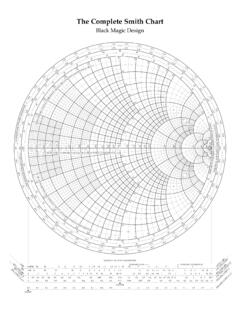Transcription of tutorials - No Magic, Inc
1 tutorials version magic , material contained herein is considered proprietary information owned by No magic , Inc. and is not to be shared, copied, or reproduced by any means. All information copyright 1998-2011 by No magic , Inc. All Rights 1998-2011 No magic , MAGICDRAW BASICS5 STEP #1 Create a class diagram5 STEP #2 Create a new class element in diagram7 STEP #3 Create package element in diagram9 STEP #4 Create new class element from browser11 STEP #5 Draw relationships11 STEP #6 Presentation options13 STEP #7 Browser options13 SEQUENCE DIAGRAM CREATION15 STEP #1 Create a Robustness diagram15 STEP #2 Create sequence diagram15 STEP #3 Create lifelines15 STEP #4 Link messages and alternative fragment17 JAVA REVERSE TO SEQUENCE DIAGRAM19 STEP #1 Create code engineering set19 STEP #2 Create sequence diagram from java source21 STEP #3 Extend sequence diagram by method25 APPLYING DIFFERENT COLORS27 STEP #1 Select all analogous shapes28 STEP #2 Open the Properties dialog box28 STEP #3 Open the color dialog box30 STEP #4 Change properties using Project Options dialog box31 STEP #5 Extend properties by implementation diagram31 APPLYING IMAGES TO STEREOTYPES34 STEP#1 Organize Stereotypes in
2 The Browser, Model Extensions Tree34 STEP#3 Choose an icon for the stereotype35 STEP#4 Applied Stereotype Property36 STEP#5 Suppress attributes and operations36 DATA PARTITIONING38 STEP #1 Export a new Module38 STEP #2 Open module as a new project39 STEP #3 Reload the module40 PERFORMING ROUND TRIP41 STEP#1 Add elements to the newly created code engineering set41 STEP#2 Generate code42 STEP#3 Add a new LuggageException class to the model43 STEP#4 Create class element in the project using reverse44 STEP#5 Separate luggage into two types 45 CODE GENERATION AND REVERSE46 STEP #1 Create a new code engineering set464 Copyright 1998-2011 No magic , #2 Add data you wish to generate 46 STEP #3 Generate code47 STEP #4 Edit generated source47 STEP #5 Reverse modified source code48 INTEGRATION WITH CVS49 STEP #1 Define main CVS options49 STEP #2 Check out from scratch a new module on your disk 50 STEP #3 Add project to CVS50 STEP #4 Commit project to CVS after making changes51 STEP #5 Update CVS project51 USING TEAMWORK SERVER52 Getting Started with Teamwork Server52 STEP #1 login to the teamwork server52 STEP #2 create teamwork server users53 STEP #3 create teamwork project54 Editing Teamwork Projects54 STEP #1 Login to the teamwork server54 STEP #2 Open teamwork project 55 STEP #3 Commit Project to Teamwork Server55 STEP #4 Lock elements for editing56 STEP #5 update teamwork project57 XML SCHEMA MODEL CREATION58 STEP #1 Create XML Schema Diagram Model58 STEP #2 Create Model Types59 STEP #3 Specify Sequence Order60 STEP #4 Code Generation from Schema Model62 Copyright
3 1998-2011 No magic , MAGICDRAW BASICSSTEP #1 Create a class diagram1. Create a new project in MagicDraw. From the File menu, choose New Project and then select the Blank Projecticon. Name the project or leave it untitled by default and click BASICS6 Copyright 1998-2011 No magic , In the diagrams toolbar, click on the Class Diagram button . The Create Diagram dialog box appears. 3. In the Type Class Diagram Name field, enter the name of the new class diagram or leave the default name. 4. From the package tree, select the package where to contain the diagram (default is Data) or create the new one by clicking the Create Owner button and choosing Package from the BASICS7 Copyright 1998-2011 No magic , Click OK.
4 The diagram is created and the diagram pane #2 Create a new class element in diagram1. In the diagram toolbar, click the Class button . Click again on the diagram pane in order to place the class. Type the name for a class. Click anywhere on the diagram pane to close the class title BASICS8 Copyright 1998-2011 No magic , The class that you see on the diagram pane is only the class symbol. All the class data are con-tained in the Browser. You can see that the class Customer has been created in the browser when you have drawn it on the diagram Double click on a class. The Class Specification dialog box appears. It contains various fea-tures of a class. For more detailed information about this dialog box, see MagicDraw BASICS9 Copyright 1998-2011 No magic , Select the Documentation/Hyperlinks group, add some documentation about this class.
5 Click #3 Create package element in diagram1. On the diagram tool bar, click the Package button . 1. Place the package on the diagram pane and name it System. Drag any corner of a package in order to reach its desired size. 2. Move a class into the package. A blue border around the package appears when the class is dragged into it and it shows that the class is included into BASICS1 0 Copyright 1998-2011 No magic , Right-click on a class to access its shortcut menu. Choose the Select in Containment Tree command. 4. The class name becomes marked by dark blue fill in the Browser BASICS1 1 Copyright 1998-2011 No magic , #4 Create new class element from browser1.
6 Right-click the System package symbol in the Browser tree. From the shortcut menu, choose the New Element option and then A new class in the package will appear in the Browser tree. Name the class Ticket. 3. Select the class in Browser and drag it onto the Diagram pane into the #5 Draw relationships1. In the diagram toolbar, click on the Association button . Connect the two classes with this path. If it is allowed to draw the link from one element to another, a blue border appears around To change the style of the path, click on special buttons in the toolbar. 3. Double click on the path. The Association Specification dialog box appears. NOTEYou can draw some paths by clicking handler buttons on the class symbol. NOTE: For more detailed information about this dialog box, see MagicDraw HelpMAGICDRAW BASICS1 2 Copyright 1998-2011 No magic , In the Name field, enter the path name owns.
7 Click Drag the association name link around and leave it on the diagram pane. Select the link. From the main toolbar, using a special Reset Labels Positions button , put the path s name into place.:NOTE: The same action can be performed using handler on the BASICS1 3 Copyright 1998-2011 No magic , #6 Presentation options1. Click on a class to select it. On the toolbar, go to the symbol editing buttons and click the Fill Color. Choose a color and click on it. The class fill color has been Click on Text Color. Choose a color and click on it. The class text color has been changed. 3. Click on an association to select it. Go to symbol editing toolbar and click Line Color. Choose a color and click on it. The association line color has been changed.
8 STEP #7 Browser options1. In the left down Browser, click on the Documentation tab . The Docu-mentation window will appear. Select a class containing the documentation. The documenta-tion of a class will appear in the Documentation Click on the Zoom tab . The Zoom window will :If not all symbol editing buttons are displayed on the diagram toolbar, from the toolbar shortcut menu, select the Expert Mode check BASICS1 4 Copyright 1998-2011 No magic , Zoom in/out the picture by dragging the slider of the sliding scale to over/under 100% or zoom in/out the picture by dragging the blue border around the diagram in Zoom :To add slider to the Zoom tab, from the Options main menu, choose Environment and in the opened dialog box, Browser group, select the Show diagram zoom slider check 1998-2011 No magic , SEQUENCE DIAGRAM CREATIONThis guide contains step-by-step instructions, showing how to create a sequence creating a sequence diagram, an example of the magic Test system will be #1 Create a Robustness diagram1.
9 Create a new In the Browser tree, from the Data package shortcut m enu, choose New Diagram > Custom Diagrams > Robustness Diagram. Name the Robustness diagram as magic In the diagram draw elements, displayed in the Figure 1 on page 1 -- The Design robustness diagramSTEP #2 Create sequence diagram1. In the Browser tree, from the Data package shortcut menu, choose New Diagram > Sequence Diagram. 2. Name diagram as Change #3 Create lifelinesi. Try below listed lifelines creation ways: Drag and drop the Instructor actor from the Browser to the diagram pane (Note: you can also perform this action for multiple selection). Draw lifeline from the diagram toolbar: 1.) In the sequence diagram toolbar, click the Lifeline button . 2.) Click on the diagram pane in order to draw a shape. 3.) From the lifeline shortcut menu select Type drop down list and select lifeline type DIAGRAM CREATION1 6 Copyright 1998-2011 No magic , 2 -- The Change Password sequence diagram, lifeline with Instructor typeii.
10 In the same way in the sequence diagram create lifelines for the LoginDialog, SystemAccessManager, Pro-fileManager, InstructorProfile 3 -- The Change Password sequence diagramiii. You can display Image instead of lifeline shape. To change the lifeline representation on the diagram pane:1. On the diagram pane from the lifeline shortcut menu select Symbol(s) Properties. The Prop-erties dialog Change the Show Stereotypes property to Shape Change the same property for the rest of 4 -- The Change Password sequence diagram - images displayed instead of Lifeline shapesSEQUENCE DIAGRAM CREATION1 7 Copyright 1998-2011 No magic , #4 Link messages and alternative fragmenti. Create Instructor message to LoginDialog:1.










